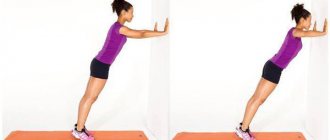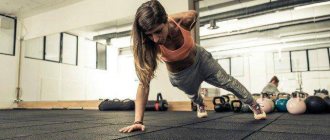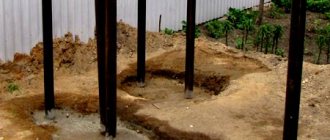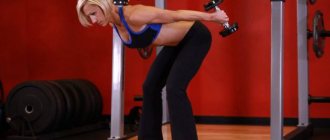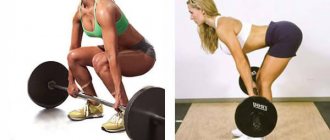Pull-ups are undoubtedly the most popular exercise among athletes training on sports grounds. May only be inferior to dips. There are many types of pull-ups and they are all aimed at developing the muscles of the back and arms.
Doing pull-ups is a simple task, and most people can do it. For those who already find it too easy, there are weighted pull-ups. And for athletes who have achieved high results in training on the bar and who cannot be surprised by ordinary pull-ups, there is one rather difficult exercise - one-arm pull-ups.
In order to master the ability to do one-arm pull-ups and technically correct execution, you need to thoroughly prepare by studying and following all the recommendations and requirements listed below.
First level
There are 2 approaches:
- You can do the absolute minimum and hope that it will be enough.
- Lay a solid foundation in preparation for this exercise.
Better, of course, is the second option. But keep in mind that even if you do everything “right,” problems can still arise. This is the main feature of training at this level.
Minimum standards. Do not attempt one-arm pull-ups unless you can meet the following requirements:
- men: at least 12 strict pull-ups with excellent technique.
- Women: At least 8 strict reps with excellent form.
It is impossible to start doing pull-ups with one arm if you have difficulty doing the exercise with both. But there is a high probability of injury. Recommended standards. This is something you really need to aim for before moving on to this difficult exercise.
- men: at least 15-20 strict pull-ups with excellent technique. And weighted pull-ups (at least 50% of your body weight - 1 rep or 3 pull-ups with 25% of your body weight).
- women: at least 10-12 strict reps with excellent form and weight (at least 25% of your body weight - 1 rep or 3 pull-ups with 15% of your body weight).
Read about how to quickly increase the number of pull-ups here.
Can a girl do a one-arm pull-up?
Without any doubt, but this is more difficult to do than for men due to the fact that women traditionally have less developed upper bodies. It's not about gender, but about muscle development.
Common mistakes made by newbies
When practicing this sport, beginners often make the following mistakes:
- when pulling themselves up, they hold onto the hand of the other hand, and the upward movement occurs due to the hand;
- immediately give a greater load. It must be gradual;
- They don’t do warm-ups before classes. This is a common cause of muscle and tendon strains;
- breathing incorrectly;
- deflect the torso from the vertical, sway while performing the exercise;
- pull up in jerks, not at a slow pace.
Preparation for training
If you're still working on classic pull-ups (for example, increasing the number of reps or doing weighted pull-ups), you can make some changes to your training to start preparing for the exercises. They are not mandatory strategies, but they will certainly help you build a strong foundation.
- Use fewer fingers (one or two hands) - use four fingers for a week or two, then three, two and even one (i.e. middle finger).
- Focus on one arm at a time (i.e. pull more on one side) during some of your sets.
- Perform different types of exercises: “around the world”, “archer”, “walking”.
- Try doing pull-ups with a single-handed grip (for example, grabbing the horizontal bar with one hand and your wrist with the other).
Contraindications
Exercises on the horizontal bar have a small number of contraindications. People with diseases and disorders such as:
- Scoliosis (curvature of the spine);
- Herniated discs;
- Protrusion of the spine.
People with osteochondrosis should exercise on the horizontal bar with caution. On the one hand, exercises help to increase blood circulation and develop mobility of vertebral structures, on the other hand, excessive stress in case of degenerative changes in the vertebrae is contraindicated. People with osteochondrosis of the cervical spine should be especially careful: pull-ups can increase pain and cause dizziness.
source: https://yoursport.com
One arm pull up workout
There are five main steps to achieving success. However, since progress is quite slow, additional tricks will be needed to make the transition from step to step. Plus, five steps sounds a lot easier than 10+, which is likely a more accurate number for most people. Step 1.
Hanging by one hand.
Instructions: Hang with a neutral wrist position, elbow straight, shoulder relaxed.
Goal: Achieve 30-60 seconds on each side.
Hanging with your shoulder tense.
Instructions: Hang with a neutral wrist position, elbow straight, shoulder tight and down, torso tight.
Goal: Achieve 30-60 seconds on each side.
Scapular pull-ups.
Instructions: Wrist and elbow positions are the same. Alternately tense and relax your shoulder.
Goal: 5 smooth reps on each side.
Step 2.
- Hang with your elbow bent at 90 degrees. Instructions: Hang with elbow bent 90 degrees, chest tight, wrist in neutral position. The body is tense. Exhale slowly throughout the exercise. Goal: 15-30 seconds.
- Hang with an elbow angle of 45 and 120 degrees. Instructions: Same as exercise above except different position (range of motion). Goal: 15-30 seconds.
- Hanging with your chin over the horizontal bar. Instructions: Neutral forearm position with elbow fully bent. Chin over the horizontal bar. Goal: hold for 15-30 seconds.
Step 3.
Negative pull-ups (downward movement). The main exercise for building sufficient strength. Learn to do them as slowly as possible. Instructions: Using a bench or chair, rise to the top position, grab the horizontal bar, chin over the horizontal bar, slowly and smoothly lower yourself to a fully extended elbow position. The body is tense. Exhale slowly through your mouth. Goal: 5 slow reps.
Step 4.
Assisted pull-ups.
At this stage a little help is needed and only during a specific phase of the exercise. Most get stuck at the very bottom, or are missing a few millimeters to complete the upward movement. The assistant will help you overcome these dead ends.
Very important: there should be as little help as possible. The less help, the more benefits.
Instructions: Use a partner, rubber band, or towel to support some of your body weight. Tighten your torso, move your shoulder down and your shoulder blade back to begin the upward movement. Bend your elbow until your chin is over the bar. Goal: Complete up to 5 slow reps with minimal assistance.
Step 5.
Self-pull-up.
After all the previous steps, you will be very close to victory.
Instructions: continue performing the exercises with the help of an assistant and in the negative phase. Your body is almost ready to do a pull-up, so sometimes turn on the camera, hang on the horizontal bar and press as hard as you can. Goal: Pull-ups on each arm.
Execution technique
How to do this exercise correctly? Despite its apparent simplicity, there are several nuances that should be followed, both to increase the overall effectiveness of the approach and to reduce the risk of injury, which was written about earlier. The classic execution technique involves the following procedure:
- Approach a projectile of suitable height. The height is determined so that while on the crossbar, you can lightly touch the floor with the tips of your socks. This is necessary in order to smoothly descend from the apparatus during operation in failure mode and minimize the torsional load on the spine, thus achieving maximum stretch.
- Place your palms at the required width from each other. The definition of width is two palms on each side of shoulder width.
- Grasp the apparatus, slightly bending your legs under you, to level out the use of the leg muscles when pulling up.
- Slowly pull yourself up, maintaining an arch in your back.
- Next, linger at the top point for 1-2 seconds.
- After this, start descending from the projectile as slowly as possible.
- The lowest point should not be in full extension of the elbows. It is enough to maintain a 10-15 degree bend. This will reduce the load on the joints, avoid a 30-degree ligamentous barrier, and most importantly, retain part of the static load on the target muscle groups.
- Rise up to the bar again.
The pace of the exercise is very moderate. For explosive pull-ups, it is better to use other grip variations.
When working with weights, you need to pay special attention to breathing. Inhale on the way down, exhale on the way up
Particularly during pull-ups, the spine is slightly stretched. And jumping sharply compresses the stretched muscles and vertebrae, which can lead to pinching in case of strong preliminary stretching.
httpv://www.youtube.com/watch?v=embed/bwvIZ1vB-9Q
Other useful tips
There can always be many pitfalls in training. Some things will happen quickly and easily, while some exercises will seem impossible. For example, you can do a lot of scapular pull-ups, but you won't be able to hang with your elbow bent for more than 2-3 seconds. So feel free to use a towel, a tourniquet, or a second hand. The main thing is to constantly increase the load, even microscopically, in each workout. Here are some ways:
- Use both hands - one as your main working hand and the other for support. Use 1 or 2 fingers for support.
- Hold on to a rubber band or towel to help you overcome stuck spots. The lower you hold them, the more stress on your dominant hand.
- Your partner can help you, but his help should be minimal.
If you are stuck at some stage for a month or more without progress, you need to return to the previous one and work it more deeply (for example, with additional weight).
Example: You do 5 negative reps well, but you can’t get a full pull-up without a lot of help. Here, performing “negatives” with weight (5-15% of your own body weight) or hanging from a bent elbow also with (5-15% of body weight) will come to the rescue. This will definitely help.
Another option is Australian one-arm pull-ups with weights. Here you can progress for a very long time (1-5 repetitions with heavy weights) .
Safety
1-arm pull-ups are more complex exercises. They require the athlete to have a professional level of preparedness, since the muscles of the arms and back must be very strong. Because of this, the exercise is not recommended for beginners.
Athletes with sore backs or shoulder joints should not do such pull-ups. In this type of exercise, a huge load is placed on the back, shoulders and biceps, so any injury from the past can make itself felt.
To further protect your body from injury, it is important to lift and lower your body slowly . Under no circumstances should you “throw” your body down or lift it up too sharply. At this moment, the joints begin to receive a very heavy load.
Secrets of success
- Exercise as often as possible. But 2 times a week will be enough. Larger amounts can lead to overtraining.
- Go step by step, don't skip. Devote one week (minimum) to a month to each stage.
- Use the variations that work best to develop extra strength. But the main emphasis is on the most difficult moments.
- Don't neglect injury prevention. Don't forget about warming up, especially your elbow and shoulder joints. Always train with proper technique.
- Remember to get proper rest and sleep between training sessions.
- Be patient - it may take quite a long time to achieve the first result. For most - from several months to 1 year. Therefore, be patient and give yourself a break when you need it. Switch to training other muscle groups.
The main thing is not to retreat and not to give up! Consistency and perseverance will lead to results!
Working on your first one-arm pull-up is not very different from doing a two-arm pull-up. It just takes longer and requires more careful attention to the training process. One thing is certain - you will learn how to do pull-ups if you really want it and are willing to work tirelessly.
Good luck!
Possible problems
Many people don’t know what to do if their arms hurt after doing pull-ups. The problem is real and cannot be ignored.
First you need to understand what kind of pain. If it is caused by muscle pain after serious exercise, then there is nothing to worry about, it will hurt and get stronger.
You need to be wary of another type of discomfort, such as pain in the joint area, or aching point in the muscle. It can be caused by tissue damage.
It is necessary to resume training only in case of complete recovery and absence of pain.
You should not succumb to the provocations of your comrades who encourage you to continue exercising, otherwise you may get an injury that is incompatible with playing sports.
If the pain continues after a long period, you should consult a doctor.

